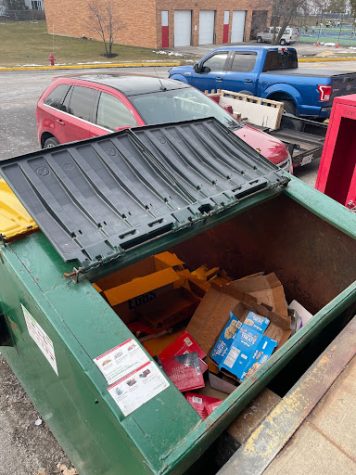Money Talk: Saving, Spending and Investing in High School
High school is a time filled with changes. These changes could include getting a driver’s license, having a job for the first time, or other such events that prepare one for adulthood.
With these new experiences and steps toward newfound independence, the subject of finance can become particularly significant. For example, I have personally learned a lot about money management recently since I got my driver’s license, and it has helped me gain a better understanding of how to handle my own money, which will likely be beneficial in the future.
“It’s important for each of us to learn personal responsibility with finances as early as possible,” Chad Oldham, math teacher who previously worked in finance, said. “Though the stakes tend to get a little higher as you grow older and take on more responsibility, learning about the necessary expenses you have or will have in the future and how those change over your lifetime can really give you a handle on what to expect and how to prepare.”
Opening a savings account will be useful to ensure a person has money available in case it is needed in the future, said Personal Finance Teacher Amy Amber. She said that setting money aside for savings regularly is something that she wishes she had done when she was younger.
“I wish I would have always put part of my paycheck from my part-time job directly into my savings account,” Amber said. “Intentionally trying to grow your savings account will definitely put you in a better financial position.”
A popular type of savings account, a high-yield savings account, offers the ability to save money and grow savings. People still have free access to money with a high-yield savings account, unlike other forms of investment. The-high yield savings accounts also boast a higher annual percentage yield than traditional savings accounts, which means a greater return for the saver.
“With the national average APY [annual percentage yield] on savings accounts at just 0.06 percent, it’s very likely that no matter what your high-yield account offers, it will still outearn a normal savings account,” said Elizabeth Gravier in an Aug. 20, 2020, CNBC article titled “What a high-yield savings account is and how it can grow your money.”
Some high-yield savings accounts do have lesser known factors to be aware of, such as monthly fees and minimum balance requirements, so interested savers should read the fine print.
“I would recommend doing your research and find a high interest savings account that meets your needs,” Amber said. “Using a website, such as Bankrate.com, will give you a comparison of various institutions that offer high interest savings accounts.”
Spending money is inevitable, but Amber said understanding how people spend their money will help them control it. A good understanding of where their money is going can help them decide on cost-cutting measures and plan ahead for future purchases.
“Pay attention to how you spend your money– write it down, so you can later analyze your spending habits,” Amber said. “Try cutting out small purchases, such as buying a coffee or drink; try making your coffee at home or bring snacks from home when you go out.”
For people who use a debit card or credit card on a regular basis, I have found the online banking feature from my bank to be very useful in tracking spending patterns. The platform offered by my bank records my transactions and gives me a breakdown of how much I am spending on different categories, such as food, entertainment and transportation. I can access all of this information from the bank’s app or website, and I have found it to be a user-friendly and helpful tool.
Finally, let’s talk about investing and how to make one’s money work to improve one’s financial stability. People can invest money in several ways with some ways containing more risk than others.
“Learn to save a portion of what you earn, and invest it. Put away a portion, no matter how small of an amount that may be. Even small amounts grow over a long period of time,” Oldham said. “That can be as simple as a very low-risk savings account with your bank, or you can talk with your bank about other ways to put your money to work. Some of those ways, like the stock market, come with significant upside potential, but also a much higher risk.”
Despite the risks of the stock market, it is one of the most popular methods of investing money and can be very effective. A safer way to cash into this opportunity, Oldham said, is by investing in index funds.
“One of the easiest ways to start investing in the stock market is through index funds. Index funds are a large portfolio of stocks that are formed to follow along with market indexes,” Oldham said. “For example, the S&P 500, an index that aims to track the overall health of the stock market, is made up of (slightly over) 500 stocks. While it would be very expensive to own each of those stocks, you can purchase a smaller selection of stock that represents the entire list.”
Oldham said it should be noted that going the index fund route doesn’t have as great a potential for huge profit and still has a margin of risk involved. Nonetheless, it is a great way to get acquainted with the market as a beginner.
Additionally, Oldham said the best way to avert investment risk is time.
“Perhaps the most essential thing I’ve learned about investing is that time is the single greatest factor for both safety and growth. Starting to save and invest early, no matter how little or how much you’re able to do, is so important,” Oldham said, “Stocks, even indexes, are prone to go up one day and down the next. But over time, you’re hoping that the peaks outweigh the valleys.”



![MHS Alum Trey Baker hosting a MBK rising event on February ninth at the MHS annex. Said Baker, “I’m just really excited [and] super grateful for the community of Mundelein, for our educators, for our administration, at MHS who are really buying into this.”](https://mhsmustang.com/wp-content/uploads/2023/03/TreyBaker-350x475.jpg)

